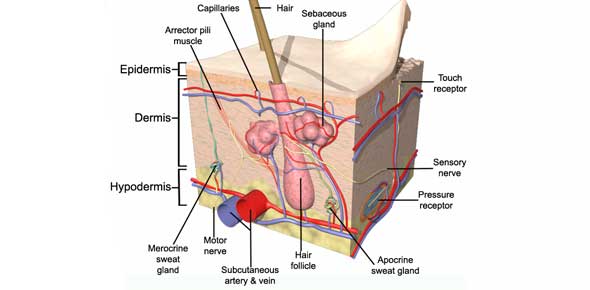A&p 2113 @ Gwinnett Tech - Chaper 5, The Integumentary System

A&P 2113 @ Gwinnett Tech - Chaper 5, The Integumentary System
- 1.
Your skin accounts for about _______% of your body weight.
- A.
21
- B.
16
- C.
11
- D.
6
Correct Answer
B. 16Explanation
The correct answer is 16. This means that approximately 16% of a person's body weight is accounted for by their skin. The skin is the largest organ in the body and plays a crucial role in protecting the internal organs, regulating body temperature, and sensing touch, among other functions. While the exact percentage may vary slightly from person to person, 16% is a generally accepted estimate.Rate this question:
-
- 2.
The cutaneous membrane has two components, the _____ and the _________.
- A.
Epidermis & hypodermis
- B.
Epidermis & dermis
- C.
Dermis & hypodermis
- D.
Epidermis & subcutaneous layer
Correct Answer
B. Epidermis & dermisExplanation
The cutaneous membrane, also known as the skin, is composed of two main layers: the epidermis and the dermis. The epidermis is the outermost layer of the skin, providing protection against external factors and regulating the loss of water. The dermis lies beneath the epidermis and contains various structures such as blood vessels, hair follicles, and sweat glands. Together, these two layers work in coordination to maintain the integrity and functionality of the skin.Rate this question:
-
- 3.
The hypodermis is made of which kind of connective tissue?
- A.
Loose
- B.
Dense irregular
- C.
Cartilage
- D.
Epithelial
Correct Answer
A. LooseExplanation
The hypodermis is made of loose connective tissue. This type of connective tissue is characterized by a loose arrangement of cells and fibers, allowing for flexibility and movement. The hypodermis, also known as the subcutaneous tissue, is located beneath the dermis and serves as a layer of insulation and padding for the body. It also contains blood vessels and nerves that supply the skin.Rate this question:
-
- 4.
Which of the following is NOT a function of the skin?
- A.
Protection
- B.
Excretion (of salts)
- C.
Maintenance
- D.
Production of lipids
- E.
Sythesis of vitamin D
- F.
Storage
- G.
Detection of touch, pressure, pain and temprature
Correct Answer
D. Production of lipidsExplanation
The skin produces melanin, not lipids.Rate this question:
-
- 5.
Which is the correct order of the strata (layers) of the epidermis?
- A.
Stratum Germinativum, Stratum Lucidum, Stratum Spinosum, Stratum Ganulosum, Stratum Corneum
- B.
Stratum Germinativum, Stratum Lucidum, Stratum Ganulosum, Stratum Corneum, Stratum Spinosum
- C.
Stratum Germinativum, Stratum Spinosum, Stratum Ganulosum, Stratum Lucidum, Stratum Corneum
- D.
Stratum Germinativum, Stratum Ganulosum, Stratum Spinosum, Stratum Lucidum, Stratum Corneum
Correct Answer
C. Stratum Germinativum, Stratum Spinosum, Stratum Ganulosum, Stratum Lucidum, Stratum CorneumExplanation
The correct order of the strata (layers) of the epidermis is Stratum Germinativum, Stratum Spinosum, Stratum Granulosum, Stratum Lucidum, and Stratum Corneum. The Stratum Germinativum is the innermost layer where new cells are produced. The Stratum Spinosum is the layer above it, followed by the Stratum Granulosum. The Stratum Lucidum is a translucent layer found only in thick skin, and the outermost layer is the Stratum Corneum, consisting of dead cells that provide protection to the skin.Rate this question:
-
- 6.
In this stratum of the epidermis, hemidesmosomes attach the cells of this layer to the basal lamina (basement membrane) that seperates the epidermis from the areolar tissue of the adjacent dermis.
- A.
Stratum Granulosum
- B.
Statum Germinativum
- C.
Stratum Lucidum
- D.
Statum Corneum
Correct Answer
B. Statum GerminativumExplanation
The correct answer is Stratum Germinativum. In this layer of the epidermis, hemidesmosomes attach the cells to the basal lamina, which separates the epidermis from the dermis. The stratum germinativum is also known as the stratum basale and is responsible for the constant renewal of the epidermis through cell division. It is the deepest layer of the epidermis and contains stem cells that give rise to the other layers.Rate this question:
-
Quiz Review Timeline +
Our quizzes are rigorously reviewed, monitored and continuously updated by our expert board to maintain accuracy, relevance, and timeliness.
-
Current Version
-
Mar 20, 2023Quiz Edited by
ProProfs Editorial Team -
Feb 15, 2012Quiz Created by
Yobeccah


